Wednesday, August 16, 2006
August 16, 2006
On the road, again…. Yes, indeed. Now a chance to relax. All I need do is drive carefully for three days and I’m home free. This is the first chance I’ve had all summer to breathe easy – you’re always “on” when leading a major project such as Cincinnati Museum Center’s Dinosaur Field School.
What happened on Monday? Clockwork. Although it was a long, hard, worrying day, everything went fine. I picked up the trailer, made the necessary adjustments and changes, found some discarded pallets, cleaned up the “Dodson” Site with Sara, Sam and Mac, got new license plates for the (still sort of) new truck, and waited for the loader to arrive – which it did. Some large nylon tie-down straps and an hour or so of care later and the Diplodocus dorsal series was secure on the trailer. Thanks, all! We really appreciate your help. A visit to some truck scales showed that our minimum estimate was dead-on – 3500 lbs. What a relief to know certainly that we have not exceeded our gross weight limits. Still, pulling a trailer takes some care, so I’ll ease it on down the highway, probably arriving at the Museum on Friday.
The rest of the gang are closing up Mother’s Day in the next few days – finishing up collecting, covering for the winter to protect against exposure and vandalism (we’ve never had any problems), and then – heading to Utah! Don spent a week at his thesis site near Castledale and returned with news that he had found some good material but hadn’t time to collect it. So – everyone jumped to his aid with offers to help him complete his M.S. research and I gave them my blessing to go. They will probably have a week of work before the season ends and all are back in Cincy. Make hay while the sun shines (or the roads are not muddy) as they say. An extra week for the gang will be good experience for all, help out Don, salvage some significant fossils for the benefit of all, and adds little to the total cost of the summer field work (they are camping – and dieting! – after all). I expect that Mason will be able to continue the blog at some point to let you (and me) know how things have gone.
As for me, I’m signing off (for now). Look for an update or two to follow about how arrival at the Museum went and where one might see these fossils now (our exhibit prep lab, I hope). Indeed, we may continue this blog on occasion with info about preparation of the fossils. I also have a great Allosaurus project you may like to hear about. Until then, all the best, come and visit. and keep on supporting those museums!
Cheers, G-
What happened on Monday? Clockwork. Although it was a long, hard, worrying day, everything went fine. I picked up the trailer, made the necessary adjustments and changes, found some discarded pallets, cleaned up the “Dodson” Site with Sara, Sam and Mac, got new license plates for the (still sort of) new truck, and waited for the loader to arrive – which it did. Some large nylon tie-down straps and an hour or so of care later and the Diplodocus dorsal series was secure on the trailer. Thanks, all! We really appreciate your help. A visit to some truck scales showed that our minimum estimate was dead-on – 3500 lbs. What a relief to know certainly that we have not exceeded our gross weight limits. Still, pulling a trailer takes some care, so I’ll ease it on down the highway, probably arriving at the Museum on Friday.
The rest of the gang are closing up Mother’s Day in the next few days – finishing up collecting, covering for the winter to protect against exposure and vandalism (we’ve never had any problems), and then – heading to Utah! Don spent a week at his thesis site near Castledale and returned with news that he had found some good material but hadn’t time to collect it. So – everyone jumped to his aid with offers to help him complete his M.S. research and I gave them my blessing to go. They will probably have a week of work before the season ends and all are back in Cincy. Make hay while the sun shines (or the roads are not muddy) as they say. An extra week for the gang will be good experience for all, help out Don, salvage some significant fossils for the benefit of all, and adds little to the total cost of the summer field work (they are camping – and dieting! – after all). I expect that Mason will be able to continue the blog at some point to let you (and me) know how things have gone.
As for me, I’m signing off (for now). Look for an update or two to follow about how arrival at the Museum went and where one might see these fossils now (our exhibit prep lab, I hope). Indeed, we may continue this blog on occasion with info about preparation of the fossils. I also have a great Allosaurus project you may like to hear about. Until then, all the best, come and visit. and keep on supporting those museums!
Cheers, G-
Monday, August 14, 2006
Dinosaur finds!
 Field-schooler Bob Bergstein enjoys time with his find.
Field-schooler Bob Bergstein enjoys time with his find. Diplodocus block at the “Dodson Site” shows signs of real progress.
Diplodocus block at the “Dodson Site” shows signs of real progress.  Sara’s block is nearly ready to go!
Sara’s block is nearly ready to go!
 Example of in place chert pebble at the Mother’s Day site suggests our dinosaurs carried stomach stones (gastroliths).
Example of in place chert pebble at the Mother’s Day site suggests our dinosaurs carried stomach stones (gastroliths). Newly exposed radius (forearm) awaits collection.
Newly exposed radius (forearm) awaits collection. Juvenile scapula (shoulder blade) lies among ribs at the Mother’s Day site.
Juvenile scapula (shoulder blade) lies among ribs at the Mother’s Day site.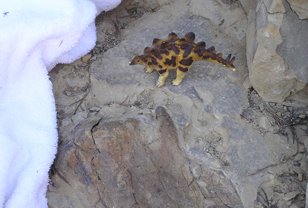 Stegosaurus comes to call on Diplodocus caudal vertebra (tail bone)!
Stegosaurus comes to call on Diplodocus caudal vertebra (tail bone)!
The land, the crew and the moose
 Textbook example of sandstone cross-bedding shows evidence of ancient river currents in rocks of Petroglyph Canyon.
Textbook example of sandstone cross-bedding shows evidence of ancient river currents in rocks of Petroglyph Canyon.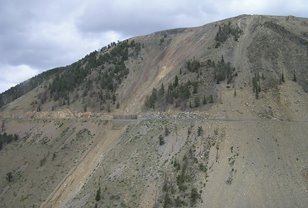 The Beartooth Highway is again open after last year’s catastrophic landslides.
The Beartooth Highway is again open after last year’s catastrophic landslides. Crew members seek refuge from the sun at Mother’s Day Quarry.
Crew members seek refuge from the sun at Mother’s Day Quarry. Mama moose (Cowwinkle?) pays a visit to Glenn’s cabin.
Mama moose (Cowwinkle?) pays a visit to Glenn’s cabin. Saturday, August 12, 2006
August 12, 2006
A lot has happened since I was last able to check in. Apologies to those on the edge of your respective seats….
First, my promise to type about the Yellowstone-Bighorn Research Association – then an update.
The YBRA is a fantastic place. Perched on the flank of Mount Maurice, overlooking Red Lodge and the start of the Beartooth Highway (Charles Kurault’s “most beautiful highway in America”), it has been home to countless geologists and students for 70 years. Begun by Princeton and a consortium of other schools, including the University of Cincinnati, geology majors have repeatedly been plunked here in the midst of spectacular scenery (both aesthetic and geologic) for exposure to basic field geology and techniques. Many YBRA students have gone on to become geologists themselves, frequently professors returning to camp to teach the next generation. Thus, a strong sentimental regard exists for the place among generations of geologists (I myself first came here as a graduate student in 1983).
It has long been my desire to prevent my crew and dino school participants from learning much about the faculty cabin that I have worked my way up to over the years. Starting in a student dorm where these folks now stay – I now find myself with an embarrassment of luxuries. It can’t be helped, however, they inevitably learn of my private cabin complete with shower and bathroom facilities and mini-fridge – also the best view in town. The downside is that no matter how long I stay here, I still find myself out of breath after each short climb to the high-rent district. In any case, no one has yet suggested that I am not entitled. After all, it’s hard work out here for a month straight and would be much more fun, I’m sure to attend field school than to lead it – leadership weighing heavily, etc.
No matter. I’m off to Mother’s Day camp tomorrow after today’s paperwork catch-up and an afternoon at the Bearcreek Centennial celebrations. Camping has it’s own pleasure’s, as you’ve already learned. And who wants to be left out of the shenanigans as detailed by Mason?
This week has been an eventful one. Alex and Jen chaperoned our student band of Jason, Tiffany, Kwaame, Davide, Samantha, Jonah, Teresa, and Lamont (apologies for any mis-spellings) out into the wilds of Montana. I honestly believe that most were happy to attend and truly gained from the experience. They certainly interacted well with our co-guests of the Franklin & Marshall alumni college, not to mention my crew (and me, I think!). They’re off home today, however, terrorist threat complications aside.
On the bone front – we collectively discovered and collected (or are now in th eprocess of doing so, a nice humerus and associated epipodial (forearm) element(s), caudal vertebrae, ribs, scapula of a small animal, foot bones, and others. The best find appears to be a jugal (facial) bone from the skull of a young individual. This year may have been the best ever for skull elements, 2002’s small braincase (cranium) notwithstanding. We also found some more skin impressions adding to our total of soft tissue preservation. These clues, along with many others, lead us to suspect a drought initiated mass-mortality, followed by debris flow mobilization of the bone bed (more on this to follow in the scientific literature in a paper by my former student Scott Myers and me).
Wildlife report adds more golden eagles, turkeys, moose, fence lizards, squirrels and chipmunks, marmots, scorpions, yellow jackets (but no more casualties!), mule deer, field mice, grasshoppers, ants, prairie chicken, pelicans(!!!), etc., and your usual lot of domesticated range fare like horses, sheep, cows, bison, llamas, and even some ole’ time cowboys complete with spurs!
In the small world department, Bob Bakker is apparently working the Cloverly exposures near Edgar as someone matching his description accosted Sam and Mac at the local filling station – “Are you with Glenn? Say hi! I’m Bob. He’ll know where to find me!” (I’m paraphrasing here). My gang is so young, however, they don’t recognize any of the old timers (save me) – even iconoclasts like Bob, so we’re only putting 2 and 2 together here (hope they don’t equal anything other than 4!).
On yesterday’s standard hike into Petroglyph Canyon, I was incensed to find that in the intervening days between now and last Saturday, some bozos had carved their names into one of the west wall art panels! The aboriginal artwork had sat largely undisturbed (OK, with a few bullet holes, perhaps) for approximately 800 years until “ANDY06” and RR06” saw fit to deface them. If you [expletive deleted]s are out there reading this, I hope you get your come-uppance in the very near future. I will see to it that the BLM learns of your (illegal, mind you) transgressions ASAP. Sad to say, they remedy for this kind of boorish, unthinking vandalism may be to restrict access to the canyon altogether. We’ll see.
My primary efforts this week have been aimed at organizing the removal of the “Dodson” block. This is a major effort that now seems to be shaping up. I have searched out a local company (wishing to remain anonymous) that is in possession of a front-end loader capable of lifting up to six tons. After stirring up a hornet’s nest (interesting corollary to the MDS camp!) with my request, the suits with law degrees have agreed to let the local guys do the job for me. Funny how lawyers and can make a whole lot of something out of what used to be accomplished on a kind word and a handshake. In any event, the locals have been very cooperative and interested from Day 1 and I very much appreciate everything that they have done and will do for us. Onwards! As we push back the frontiers of science!
Also on the Big Dig Diplodocus, we have been in need of a trailer to haul the block back to the Museum. I drove the entire northern end of the Bighorn basin over several days checking out leads and comparison shopping. The best I saw was in a small private lot in Cowley, WY. Although twice as expensive as anything else (sorry about that, you know who you are), I want to err on the side of safety as this aluminum trailer, while rated for the same gross weight, is itself lighter that steel and will thus handle a heavier payload. It also has brakes on each axle – surely important when being chased by a dinosaur on the interstates.
OK, so the trailer looked great. Getting hold of the owner/seller proved more difficult. He never seemed to be home, so I checked at the local Post Office for his contact info. Got it and called his house – left a message – no reply. Back to the PO only to learn that his mail had not been picked up for several days. Asked his wife’s name and where she worked. Toddled on over to confirm that they were on vacation, BUT returning today. Left a note at their house. Long story short, I’m meeting up with him today to get the trailer and we have a confirmed appointment with the front-end loader for Monday. Wish us luck!
As I’m camping tomorrow, you’ll have no word of our success (or dare I say it, failure) until I hit the road and the motel scene next week with dino in tow. I’ll report back as soon as I can. Mason will remain at Mother’s Day for a little longer to finish up operations there for the season. Hopefully, she will be able to “blog-on” at least once more. For my part, I’ll try to get some more pictures up too.
Cheerio!
First, my promise to type about the Yellowstone-Bighorn Research Association – then an update.
The YBRA is a fantastic place. Perched on the flank of Mount Maurice, overlooking Red Lodge and the start of the Beartooth Highway (Charles Kurault’s “most beautiful highway in America”), it has been home to countless geologists and students for 70 years. Begun by Princeton and a consortium of other schools, including the University of Cincinnati, geology majors have repeatedly been plunked here in the midst of spectacular scenery (both aesthetic and geologic) for exposure to basic field geology and techniques. Many YBRA students have gone on to become geologists themselves, frequently professors returning to camp to teach the next generation. Thus, a strong sentimental regard exists for the place among generations of geologists (I myself first came here as a graduate student in 1983).
It has long been my desire to prevent my crew and dino school participants from learning much about the faculty cabin that I have worked my way up to over the years. Starting in a student dorm where these folks now stay – I now find myself with an embarrassment of luxuries. It can’t be helped, however, they inevitably learn of my private cabin complete with shower and bathroom facilities and mini-fridge – also the best view in town. The downside is that no matter how long I stay here, I still find myself out of breath after each short climb to the high-rent district. In any case, no one has yet suggested that I am not entitled. After all, it’s hard work out here for a month straight and would be much more fun, I’m sure to attend field school than to lead it – leadership weighing heavily, etc.
No matter. I’m off to Mother’s Day camp tomorrow after today’s paperwork catch-up and an afternoon at the Bearcreek Centennial celebrations. Camping has it’s own pleasure’s, as you’ve already learned. And who wants to be left out of the shenanigans as detailed by Mason?
This week has been an eventful one. Alex and Jen chaperoned our student band of Jason, Tiffany, Kwaame, Davide, Samantha, Jonah, Teresa, and Lamont (apologies for any mis-spellings) out into the wilds of Montana. I honestly believe that most were happy to attend and truly gained from the experience. They certainly interacted well with our co-guests of the Franklin & Marshall alumni college, not to mention my crew (and me, I think!). They’re off home today, however, terrorist threat complications aside.
On the bone front – we collectively discovered and collected (or are now in th eprocess of doing so, a nice humerus and associated epipodial (forearm) element(s), caudal vertebrae, ribs, scapula of a small animal, foot bones, and others. The best find appears to be a jugal (facial) bone from the skull of a young individual. This year may have been the best ever for skull elements, 2002’s small braincase (cranium) notwithstanding. We also found some more skin impressions adding to our total of soft tissue preservation. These clues, along with many others, lead us to suspect a drought initiated mass-mortality, followed by debris flow mobilization of the bone bed (more on this to follow in the scientific literature in a paper by my former student Scott Myers and me).
Wildlife report adds more golden eagles, turkeys, moose, fence lizards, squirrels and chipmunks, marmots, scorpions, yellow jackets (but no more casualties!), mule deer, field mice, grasshoppers, ants, prairie chicken, pelicans(!!!), etc., and your usual lot of domesticated range fare like horses, sheep, cows, bison, llamas, and even some ole’ time cowboys complete with spurs!
In the small world department, Bob Bakker is apparently working the Cloverly exposures near Edgar as someone matching his description accosted Sam and Mac at the local filling station – “Are you with Glenn? Say hi! I’m Bob. He’ll know where to find me!” (I’m paraphrasing here). My gang is so young, however, they don’t recognize any of the old timers (save me) – even iconoclasts like Bob, so we’re only putting 2 and 2 together here (hope they don’t equal anything other than 4!).
On yesterday’s standard hike into Petroglyph Canyon, I was incensed to find that in the intervening days between now and last Saturday, some bozos had carved their names into one of the west wall art panels! The aboriginal artwork had sat largely undisturbed (OK, with a few bullet holes, perhaps) for approximately 800 years until “ANDY06” and RR06” saw fit to deface them. If you [expletive deleted]s are out there reading this, I hope you get your come-uppance in the very near future. I will see to it that the BLM learns of your (illegal, mind you) transgressions ASAP. Sad to say, they remedy for this kind of boorish, unthinking vandalism may be to restrict access to the canyon altogether. We’ll see.
My primary efforts this week have been aimed at organizing the removal of the “Dodson” block. This is a major effort that now seems to be shaping up. I have searched out a local company (wishing to remain anonymous) that is in possession of a front-end loader capable of lifting up to six tons. After stirring up a hornet’s nest (interesting corollary to the MDS camp!) with my request, the suits with law degrees have agreed to let the local guys do the job for me. Funny how lawyers and can make a whole lot of something out of what used to be accomplished on a kind word and a handshake. In any event, the locals have been very cooperative and interested from Day 1 and I very much appreciate everything that they have done and will do for us. Onwards! As we push back the frontiers of science!
Also on the Big Dig Diplodocus, we have been in need of a trailer to haul the block back to the Museum. I drove the entire northern end of the Bighorn basin over several days checking out leads and comparison shopping. The best I saw was in a small private lot in Cowley, WY. Although twice as expensive as anything else (sorry about that, you know who you are), I want to err on the side of safety as this aluminum trailer, while rated for the same gross weight, is itself lighter that steel and will thus handle a heavier payload. It also has brakes on each axle – surely important when being chased by a dinosaur on the interstates.
OK, so the trailer looked great. Getting hold of the owner/seller proved more difficult. He never seemed to be home, so I checked at the local Post Office for his contact info. Got it and called his house – left a message – no reply. Back to the PO only to learn that his mail had not been picked up for several days. Asked his wife’s name and where she worked. Toddled on over to confirm that they were on vacation, BUT returning today. Left a note at their house. Long story short, I’m meeting up with him today to get the trailer and we have a confirmed appointment with the front-end loader for Monday. Wish us luck!
As I’m camping tomorrow, you’ll have no word of our success (or dare I say it, failure) until I hit the road and the motel scene next week with dino in tow. I’ll report back as soon as I can. Mason will remain at Mother’s Day for a little longer to finish up operations there for the season. Hopefully, she will be able to “blog-on” at least once more. For my part, I’ll try to get some more pictures up too.
Cheerio!
Sunday, August 06, 2006
August 6, 2006
Glenn, here. I believe that Mason has had a chance to finally get into town and put up her thoughts regarding the past few weeks activities. Thus, I’m shamed into adding another post. Actually, I have an hour of downtime as the second crew is being exchanged for the third and needed to catch up on where we are.
More bones have been collected at Mother’s Day and others have turned up, including more vertebrae, long bones, a small scapula and two apparent coracoids (being mindful that field identifications can be tricky). Sara’s big block is out (just not carried to the camp – all 200 lbs. of it). We’ve been finding a number of in situ chert pebbles in the otherwise homogenous mudstone that makes us believe that they are gastroliths (stomach stones), as the dinosaurs themselves are the most obvious means of transport of such anomalous items.
My big priority, however, has been the Dodson block. Looks like we will get it out in the next week, assuming that we can find some heavy-lift equipment. I’m meeting Will Tillett, the fossil’s discoverer on-site today and he assures me that he has just the thing. At the same time, we are still eyeing trailer sales yards. Having measured the block at approximately 1.5’ x 3.5’ x 9 ‘ at a minimum and 2’ x 4’ x 9’ at a maximum (even though the block is not rectangular) we get 47.25 cubic feet vs. 72 cu. ft. or 1.75 vs. 2.67 cubic yards of rock. At 2,000 lbs. per cubic yard (estimated from the weight of compressed, crushed limestone), the block is conservatively between 3,500 and 5,333 lbs. in weight (someone shout if our math is wrong!). We think this is easily (relatively speaking!) doable. Look for more adventures on this project as we progress.
Yesterday we had another general geology and petroglyph tour, capped off by an evening at the races (only pigs won, none of us this day, sad to say). Wildlife checklist now includes more antelope and turkeys, fence lizards, a baby “horny toad” (another lizard, of course), another eagle (golden), an two large owls. Hiking down the petroglyph canyon in the blazing sun (oh yes, the fires are out, but the heat is back, at least temporarily) we ran into VERY LARGE cat tracks in the sand along our trail – a cougar! We didn’t see the lion, but I presume he saw us. I wasn’t worried, however, as I know they prefer stragglers (listen up you in the back!).
Today our youth program kids come into camp. These are high school kids that have been volunteering in the Museum and participating in CMC’s youth mentoring program. The idea is to give a diversity of kids with differing backgrounds the chance to closely interact over four years while at the same time providing an expectation that they will carry on with their educations (hopefully getting some quality volunteer efforts out of them too). The capstone project for kids interested in science is to attend the Dinosaur Field School in Montana – quite an undertaking for kids who may never have left Ohio. This effort has been so successful is inspiring kids (some to even go on as geology/paleontology majors – sorry, moms and dads!) that an anonymous donor has stepped forward for 3 years to sponsor the kid’s trips. More sponsors always welcome!
Tomorrow, we’ll have another Beartooth Plateau geology tour and start the process over again. I will also be giving a lecture to them and a group from Franklin & Marshall College about the Mother’s Day Site, Jurassic dinosaurs and the Morrison Formation (one of the premier dinosaur-bearing units in the world). I neglected to mention that the Carbon County Historical Society had tapped me for this talk some month’s ago for presentation at their museum in Red Lodge. It seemed to go rather well, but an attending geologist and YBRA ----
FLASH! - Brief interruption here as I had to look out the back window of my cabin to watch a cow moose and her calf pass within 20 ft. We then followed them across camp as they went on up the mountain (always keeping a respectful distance as it’s never good to annoy a protective mother who is the size of a mid-sized sedan). Nice exclamation point to the Montana holiday of our second week crew.
Anyhow, where was I? Oh yes, geologist and YBRA counselor, Marv Kaufmann was in attendance at my lecture. As a result, I’m giving it again to his visiting F & M alumni group and the CMC kids simultaneously. I’ll lead them all out to MDS next morning.
Next installment I believe I’ll talk about the YBRA itself (because I can’t remember if I’ve done so as yet – time and ideas sort of running together out here) and how it came to be and how we all have ended up here along with a variety of other geology students, researchers, professors and tourists.
Cheers for now.
More bones have been collected at Mother’s Day and others have turned up, including more vertebrae, long bones, a small scapula and two apparent coracoids (being mindful that field identifications can be tricky). Sara’s big block is out (just not carried to the camp – all 200 lbs. of it). We’ve been finding a number of in situ chert pebbles in the otherwise homogenous mudstone that makes us believe that they are gastroliths (stomach stones), as the dinosaurs themselves are the most obvious means of transport of such anomalous items.
My big priority, however, has been the Dodson block. Looks like we will get it out in the next week, assuming that we can find some heavy-lift equipment. I’m meeting Will Tillett, the fossil’s discoverer on-site today and he assures me that he has just the thing. At the same time, we are still eyeing trailer sales yards. Having measured the block at approximately 1.5’ x 3.5’ x 9 ‘ at a minimum and 2’ x 4’ x 9’ at a maximum (even though the block is not rectangular) we get 47.25 cubic feet vs. 72 cu. ft. or 1.75 vs. 2.67 cubic yards of rock. At 2,000 lbs. per cubic yard (estimated from the weight of compressed, crushed limestone), the block is conservatively between 3,500 and 5,333 lbs. in weight (someone shout if our math is wrong!). We think this is easily (relatively speaking!) doable. Look for more adventures on this project as we progress.
Yesterday we had another general geology and petroglyph tour, capped off by an evening at the races (only pigs won, none of us this day, sad to say). Wildlife checklist now includes more antelope and turkeys, fence lizards, a baby “horny toad” (another lizard, of course), another eagle (golden), an two large owls. Hiking down the petroglyph canyon in the blazing sun (oh yes, the fires are out, but the heat is back, at least temporarily) we ran into VERY LARGE cat tracks in the sand along our trail – a cougar! We didn’t see the lion, but I presume he saw us. I wasn’t worried, however, as I know they prefer stragglers (listen up you in the back!).
Today our youth program kids come into camp. These are high school kids that have been volunteering in the Museum and participating in CMC’s youth mentoring program. The idea is to give a diversity of kids with differing backgrounds the chance to closely interact over four years while at the same time providing an expectation that they will carry on with their educations (hopefully getting some quality volunteer efforts out of them too). The capstone project for kids interested in science is to attend the Dinosaur Field School in Montana – quite an undertaking for kids who may never have left Ohio. This effort has been so successful is inspiring kids (some to even go on as geology/paleontology majors – sorry, moms and dads!) that an anonymous donor has stepped forward for 3 years to sponsor the kid’s trips. More sponsors always welcome!
Tomorrow, we’ll have another Beartooth Plateau geology tour and start the process over again. I will also be giving a lecture to them and a group from Franklin & Marshall College about the Mother’s Day Site, Jurassic dinosaurs and the Morrison Formation (one of the premier dinosaur-bearing units in the world). I neglected to mention that the Carbon County Historical Society had tapped me for this talk some month’s ago for presentation at their museum in Red Lodge. It seemed to go rather well, but an attending geologist and YBRA ----
FLASH! - Brief interruption here as I had to look out the back window of my cabin to watch a cow moose and her calf pass within 20 ft. We then followed them across camp as they went on up the mountain (always keeping a respectful distance as it’s never good to annoy a protective mother who is the size of a mid-sized sedan). Nice exclamation point to the Montana holiday of our second week crew.
Anyhow, where was I? Oh yes, geologist and YBRA counselor, Marv Kaufmann was in attendance at my lecture. As a result, I’m giving it again to his visiting F & M alumni group and the CMC kids simultaneously. I’ll lead them all out to MDS next morning.
Next installment I believe I’ll talk about the YBRA itself (because I can’t remember if I’ve done so as yet – time and ideas sort of running together out here) and how it came to be and how we all have ended up here along with a variety of other geology students, researchers, professors and tourists.
Cheers for now.
Saturday, August 05, 2006
Home on the Range
I'm the field supervisor, which means that I spend pretty much all my time in the field -- hence this being my first entry, accomplished from an internet cafe in Red Lodge on a mission to procure more burlap. Meet our happy band!
We've been here almost three weeks now and it feels much longer. That isn't to say we aren't loving it; it means that the place hasn't changed a bit, and it feels like we never left. We are the core team of this expedition, the here-for-the-duration people who camp at the digsite and live, eat, and breathe fossils every summer. We look forward to this all year. Within hours of arriving we have fallen back into the good old patterns that sustain us in this place.
Our patterns begin with tent placement. Once we have established that the dirt road up to our campsite has sufficiently weathered the winter to allow us access, we gingerly bump the vans over the ruts and around the ditches to the narrow valley where we make camp every year. We set up personal tents first. I favor a particular low ditchy area despite its proximity to a fire ant nest because I'm avoiding wind; I have a stupidly tall tent (but it was on sale!). Sara knows better, the hard way: HER tall tent was destroyed in our Great Hail Storm of 2004. Sara confidently assembles her low, wide alpine tent right out in the open; she says it doesn't even rustle in the breeze. Mac sets up right at the common area -- he likes to be in the middle of things. Don, who endured the Great Hail Storm from underneath a van, has decided to live IN a van this year -- no tent for him. But true to his nature, Don is going the extra mile to bring civilization to our midst. He's brought a portable gazebo, "suitable for weddings and family reunions," and he intends to fill it with comfortable seating and music and DVDs run off a small generator. The wind takes takes the whole thing down in about five minutes. Eventually we get it standing but only without its legs, so it's about three feet off the ground. We call it the media yurt and crawl in to play board games sometimes.
We arrange crates of gear in a rough square and call it the living room; we put the propane stove and sink at one end and call it the kitchen. Then we grab shovels and pickaxes and trek over the rise to the digsite. It's a short walk but it's steep and we've gained about 4000 feet in elevation since Cincinnati three days earlier. Our goal now is to uncover the digsite, but we're already worn out and not much gets done that first day.
It's 15 miles to the tiny town of Bridger. We stock up on food (Tuna Helper, Chicken Helper, all the Helpers -- it's mainly mush-meals-in-a-skillet from here on). The Maverik gas station graciously allows us to fill our water jugs from their hose. And the Bridger Cafe makes the world's best milkshakes.
Back at the digsite, we are moving a lot of earth. We bury the site at the end of every season, to hide and sort-of protect it, but there's still a lot of bone washing out. We have our work cut out for us. Fossil bone is crumbling from every slope, turning blue in the sun and wind. We collect the stray chunks, called "float," and dig on the spot and there they are: ribs galore, two scapulae, maddeningly complex cervical vertebrae, a perfect and robust tibia, a radius and ulna neatly side-by-side. A whole herd of young sauropods jumbled like pick-up sticks -- an apt comparison, because removing them is LIKE playing pick-up sticks; your'e working away on one bone and whoops, there's another right on top of it. The happy cries of discovery turn to cries of dismay -- "Oh no! More bone!" -- as your initial, say, cervical is found to be blocked in by, say, a rib, and then another, and another. Patience, patience.
Sara is only 18 but she's been working with fossils for years now and she's very good at it. Furthermore, she possesses that knack for knowing where to dig that is beyond skill -- you either have it or you don't. She's found skin impressions here before (very cool) and now it looks like she's got skull. Everyone's jealous.
The cervicals that Don was removing have proven to be heavily blocked in by other elements, ribs and caudels, and yike, yet more cervicals. They will all have to come out together, in one enormous block. How will we ever move it? It keeps getting bigger. Don isn't having fun; the rock is very hard in that spot. His hammer blows are regular and constant but he knows what has to be done; some people would lose their temper and chop the block apart anyway and lose half of it, but not Don. Still, he keeps volunteering for lousy but needful tasks, like digging latrine trenches, just for a break from that awful block. Everything he does is so silent and steady -- so unspectacular are his methods -- that his spectacular results catch one off guard, as does his dark and pointy-sharp wit. I've done field work with Don for three seasons now, and he is always a surpise.
Mac has found a lovely string of tailbones. He is, like Sara, 18, and also a freshman at UC. Also, like Sara, Mac started young -- he first wrote Glenn, my boss, an email declaring his paleontological aspirations when he (Mac) was in the eighth grade. Mac's family breeds Clydesdales. The best qualities for excavating fossils -- patience, care, a steady, smooth hand, the right balance of physical strength and delicacy, intuition -- are perhaps not coincidentally the best qualities in horsework. Mac will do fine.
Dale's little red car came creeping up the path a few days later, diven, as usual, by Sam. Dale curates the Orton Geological Museum in Columbus and digs up fossils at every opportunity; one's first impression of Dale is of a happy man who loves his work. He fairly bubbles with enthusiasm, he bounces on the balls of his feet when he talks, and even his hair has a springy, fresh-popped popcorn look to it. Sam, by contrast, is tall, lean, and rangy and cultivates a Toshiro Mifune scowl, which belies his good nature, most evident when he's trading cheerful barbs with Dale. He calls Dale "Boss," which he hasn't literally been for some time -- they are actually an excellent father-son team, and it doesn't matter that they aren't related by blood. They have been working here every summer for seven years now, and they are essential to the mix.
And then came Glenn, the big boss, my boss. Why does the boss always arrive just when one is taking a much-needed heat-of-the-day siesta? But Glenn was in high spirits. For starters, he had driven out from Cincinnati in our departments' brand-spanking-new Tundra pickup, and the thing rides like a dream. Secondly, he was here, and here is wonderful, even if the temperatures are topping a hundred and the land is not only dry, it's CRISP. We wake up with dust in our throats and cracked nostrils, and everyone's hair looks like something you vacuum up from under the bed. "Good thing it's a dry heat, though," we say to each other about ten times a day -- our brains are too fried to be more creative.
Evenings are different. It cools off fast in the desert; rocks and scrub don't hold much heat. We haul ourselves back to camp around fiveish and slump dull-eyed in our lawn chairs with our backs to the blazing horizon. We slowly recover our senses and fluid levels. Whoever cooks dinner doesn't have to clean up -- that's the rule. It doesn't get dark until 10-10:30, so post-mealtime falls at just about the golden hour, a term that applies here like no where else. I have photos taken in these excellent early-evening hours from previous years, and anyone who sees them thinks I had a colored filter on my lens. But this is what it looks like: us, relaxed, fed, happy, cooling off (even in light jackets by now), bathed in a deep orange glow. We've assembled our chairs in a semicircle by now and we're sufficiently energized for the evening's shenanigans, which could be and have been:
-- board games. Dinosaur Monopoly, Cranium, poker, and weiqi, everybody in the media yurt, hunched like trolls.
-- target practice. Air rifles, bows and arrows, 22 calibers, and a slingshot, all trained on poor Mrs. Butterworth (now emptied of syrup), a half a rancid watermelon, a rubber glove full of plaster.
-- juvenile practical jokes. What if you woke up to find Mrs. Butterworth full of buckshot and a green glowstick in your tent vestibule? What if Sam did?
-- scorpion racing. They flouresce. Once you've walked around at night with a portable blacklight, you find out they are everywhere, and you'll never wear those Tevas out here again -- you're lucky if you can sleep. Or, if you're Sara, you build a racetrack from cardboard tubing and duct tape. Race 'em, trade 'em, keep them in a coffee can and feed 'em yellowjackets!
-- killing yellowjackets. They are everywhere this year, like never before. But, hard up for entertainment, anything can be a sport. Keep score! The battery-powered electric tennis racket provides, no kidding, hours of bug-zappin' fun.
-- stargazing. We all agree that it's impossible to describe this night sky to anyone back home. The Milky Way is a big white SMEAR, if that gives you any idea. We identify constellations, invent new ones. The Perseid meteor shower is in town for its annual run; we are struck dumb with awe.
-- search for topographical features, against all common sense. Don insists that "Depression Reservior" is on the map and within a two-mile radius. We pile in the back of the pickup and head out across the bone-dry, featureless plain. It turns out to be a cow wallow in a ditch about the size of someone's above-ground swimming pool. Don is disappointed -- he actually brought a fishing pole.
-- go swimming, get cleanish! Not in Depression Reservior, but in Cooney Reservior about 50 miles away. Yes it's muddy, but what a treat, not to mention the first opportunity to bathe in a week. Dr Bronner's soap is biodegradable and also has very entertaining label copy. What's a little mud? This is the desert, people, you think water grows on trees?
-- s'mores. Why not?
-- call home. It can now be done. Take a short walk to high ground and talk as long as your overheated cell phone battery will allow.
-- pointless bickering. There are, apparently, only three REAL Star Wars movies, and some people feel strongly about this.
-- the art of conversation. It's not all dinosaurs and Stargate.
-- actual work. Not much. That's one of the great beauties of being out here. No email, nothing you've been procrastinating on at the back of your mind -- the tasks at hand are what we got.
Every now and then someone (usually someone very YOUNG) tries to explain to me how we could get a satellite hookup out here, get online, get back in the real world. Ha. Ha. Ha.
More to come!
We've been here almost three weeks now and it feels much longer. That isn't to say we aren't loving it; it means that the place hasn't changed a bit, and it feels like we never left. We are the core team of this expedition, the here-for-the-duration people who camp at the digsite and live, eat, and breathe fossils every summer. We look forward to this all year. Within hours of arriving we have fallen back into the good old patterns that sustain us in this place.
Our patterns begin with tent placement. Once we have established that the dirt road up to our campsite has sufficiently weathered the winter to allow us access, we gingerly bump the vans over the ruts and around the ditches to the narrow valley where we make camp every year. We set up personal tents first. I favor a particular low ditchy area despite its proximity to a fire ant nest because I'm avoiding wind; I have a stupidly tall tent (but it was on sale!). Sara knows better, the hard way: HER tall tent was destroyed in our Great Hail Storm of 2004. Sara confidently assembles her low, wide alpine tent right out in the open; she says it doesn't even rustle in the breeze. Mac sets up right at the common area -- he likes to be in the middle of things. Don, who endured the Great Hail Storm from underneath a van, has decided to live IN a van this year -- no tent for him. But true to his nature, Don is going the extra mile to bring civilization to our midst. He's brought a portable gazebo, "suitable for weddings and family reunions," and he intends to fill it with comfortable seating and music and DVDs run off a small generator. The wind takes takes the whole thing down in about five minutes. Eventually we get it standing but only without its legs, so it's about three feet off the ground. We call it the media yurt and crawl in to play board games sometimes.
We arrange crates of gear in a rough square and call it the living room; we put the propane stove and sink at one end and call it the kitchen. Then we grab shovels and pickaxes and trek over the rise to the digsite. It's a short walk but it's steep and we've gained about 4000 feet in elevation since Cincinnati three days earlier. Our goal now is to uncover the digsite, but we're already worn out and not much gets done that first day.
It's 15 miles to the tiny town of Bridger. We stock up on food (Tuna Helper, Chicken Helper, all the Helpers -- it's mainly mush-meals-in-a-skillet from here on). The Maverik gas station graciously allows us to fill our water jugs from their hose. And the Bridger Cafe makes the world's best milkshakes.
Back at the digsite, we are moving a lot of earth. We bury the site at the end of every season, to hide and sort-of protect it, but there's still a lot of bone washing out. We have our work cut out for us. Fossil bone is crumbling from every slope, turning blue in the sun and wind. We collect the stray chunks, called "float," and dig on the spot and there they are: ribs galore, two scapulae, maddeningly complex cervical vertebrae, a perfect and robust tibia, a radius and ulna neatly side-by-side. A whole herd of young sauropods jumbled like pick-up sticks -- an apt comparison, because removing them is LIKE playing pick-up sticks; your'e working away on one bone and whoops, there's another right on top of it. The happy cries of discovery turn to cries of dismay -- "Oh no! More bone!" -- as your initial, say, cervical is found to be blocked in by, say, a rib, and then another, and another. Patience, patience.
Sara is only 18 but she's been working with fossils for years now and she's very good at it. Furthermore, she possesses that knack for knowing where to dig that is beyond skill -- you either have it or you don't. She's found skin impressions here before (very cool) and now it looks like she's got skull. Everyone's jealous.
The cervicals that Don was removing have proven to be heavily blocked in by other elements, ribs and caudels, and yike, yet more cervicals. They will all have to come out together, in one enormous block. How will we ever move it? It keeps getting bigger. Don isn't having fun; the rock is very hard in that spot. His hammer blows are regular and constant but he knows what has to be done; some people would lose their temper and chop the block apart anyway and lose half of it, but not Don. Still, he keeps volunteering for lousy but needful tasks, like digging latrine trenches, just for a break from that awful block. Everything he does is so silent and steady -- so unspectacular are his methods -- that his spectacular results catch one off guard, as does his dark and pointy-sharp wit. I've done field work with Don for three seasons now, and he is always a surpise.
Mac has found a lovely string of tailbones. He is, like Sara, 18, and also a freshman at UC. Also, like Sara, Mac started young -- he first wrote Glenn, my boss, an email declaring his paleontological aspirations when he (Mac) was in the eighth grade. Mac's family breeds Clydesdales. The best qualities for excavating fossils -- patience, care, a steady, smooth hand, the right balance of physical strength and delicacy, intuition -- are perhaps not coincidentally the best qualities in horsework. Mac will do fine.
Dale's little red car came creeping up the path a few days later, diven, as usual, by Sam. Dale curates the Orton Geological Museum in Columbus and digs up fossils at every opportunity; one's first impression of Dale is of a happy man who loves his work. He fairly bubbles with enthusiasm, he bounces on the balls of his feet when he talks, and even his hair has a springy, fresh-popped popcorn look to it. Sam, by contrast, is tall, lean, and rangy and cultivates a Toshiro Mifune scowl, which belies his good nature, most evident when he's trading cheerful barbs with Dale. He calls Dale "Boss," which he hasn't literally been for some time -- they are actually an excellent father-son team, and it doesn't matter that they aren't related by blood. They have been working here every summer for seven years now, and they are essential to the mix.
And then came Glenn, the big boss, my boss. Why does the boss always arrive just when one is taking a much-needed heat-of-the-day siesta? But Glenn was in high spirits. For starters, he had driven out from Cincinnati in our departments' brand-spanking-new Tundra pickup, and the thing rides like a dream. Secondly, he was here, and here is wonderful, even if the temperatures are topping a hundred and the land is not only dry, it's CRISP. We wake up with dust in our throats and cracked nostrils, and everyone's hair looks like something you vacuum up from under the bed. "Good thing it's a dry heat, though," we say to each other about ten times a day -- our brains are too fried to be more creative.
Evenings are different. It cools off fast in the desert; rocks and scrub don't hold much heat. We haul ourselves back to camp around fiveish and slump dull-eyed in our lawn chairs with our backs to the blazing horizon. We slowly recover our senses and fluid levels. Whoever cooks dinner doesn't have to clean up -- that's the rule. It doesn't get dark until 10-10:30, so post-mealtime falls at just about the golden hour, a term that applies here like no where else. I have photos taken in these excellent early-evening hours from previous years, and anyone who sees them thinks I had a colored filter on my lens. But this is what it looks like: us, relaxed, fed, happy, cooling off (even in light jackets by now), bathed in a deep orange glow. We've assembled our chairs in a semicircle by now and we're sufficiently energized for the evening's shenanigans, which could be and have been:
-- board games. Dinosaur Monopoly, Cranium, poker, and weiqi, everybody in the media yurt, hunched like trolls.
-- target practice. Air rifles, bows and arrows, 22 calibers, and a slingshot, all trained on poor Mrs. Butterworth (now emptied of syrup), a half a rancid watermelon, a rubber glove full of plaster.
-- juvenile practical jokes. What if you woke up to find Mrs. Butterworth full of buckshot and a green glowstick in your tent vestibule? What if Sam did?
-- scorpion racing. They flouresce. Once you've walked around at night with a portable blacklight, you find out they are everywhere, and you'll never wear those Tevas out here again -- you're lucky if you can sleep. Or, if you're Sara, you build a racetrack from cardboard tubing and duct tape. Race 'em, trade 'em, keep them in a coffee can and feed 'em yellowjackets!
-- killing yellowjackets. They are everywhere this year, like never before. But, hard up for entertainment, anything can be a sport. Keep score! The battery-powered electric tennis racket provides, no kidding, hours of bug-zappin' fun.
-- stargazing. We all agree that it's impossible to describe this night sky to anyone back home. The Milky Way is a big white SMEAR, if that gives you any idea. We identify constellations, invent new ones. The Perseid meteor shower is in town for its annual run; we are struck dumb with awe.
-- search for topographical features, against all common sense. Don insists that "Depression Reservior" is on the map and within a two-mile radius. We pile in the back of the pickup and head out across the bone-dry, featureless plain. It turns out to be a cow wallow in a ditch about the size of someone's above-ground swimming pool. Don is disappointed -- he actually brought a fishing pole.
-- go swimming, get cleanish! Not in Depression Reservior, but in Cooney Reservior about 50 miles away. Yes it's muddy, but what a treat, not to mention the first opportunity to bathe in a week. Dr Bronner's soap is biodegradable and also has very entertaining label copy. What's a little mud? This is the desert, people, you think water grows on trees?
-- s'mores. Why not?
-- call home. It can now be done. Take a short walk to high ground and talk as long as your overheated cell phone battery will allow.
-- pointless bickering. There are, apparently, only three REAL Star Wars movies, and some people feel strongly about this.
-- the art of conversation. It's not all dinosaurs and Stargate.
-- actual work. Not much. That's one of the great beauties of being out here. No email, nothing you've been procrastinating on at the back of your mind -- the tasks at hand are what we got.
Every now and then someone (usually someone very YOUNG) tries to explain to me how we could get a satellite hookup out here, get online, get back in the real world. Ha. Ha. Ha.
More to come!
Friday, August 04, 2006
August 3, 2006
Right! Back to dinosaur collecting. We’ve had several good days in the MDS quarry and things are going OK at “Dodson”, too. Additional vertebrae have turned up, along with paired ulna and radius of a young animal, and an additional small radius (from a 40 foot? juvenile). We have also found some new foot bones, including several ungual phalanges (claws). Each of these will need to be collected (many already have) by plaster jacketing. This is the same process used by physicians who need to set broken bones for mending. Our dinosaur bones are certainly broken – that is full of post-depositional fractures after 140 million years of compression and tectonic uplift.
So, each bone need to have all of it’s pieces immobilized, or held together in place, just as the bones of your broken leg would need to be. First we expose the bone, impregnate it with an archival consolidant (glue), trench around it so it stands on a pedestal of matrix, cover with a separating agent so that the Plaster of Paris used will not stick to the actual bone (we use wet toilet paper – TP is good for many things around camp!), and apply burlap strips soaked in plaster (people fight for a chance to cut up the strips beneath our only shade tree – a rather sad-looking Pinyon Pine). Once dry, we chisel around the plastered block and attempt to overturn it without bits of bone falling out the bottom. We usually succeed at this. The bottom is then capped with TP and plaster and the block readied for shipment home. Of course, field numbers are given the blocks so that they can be matched up with the contextual data that we have recorded for each fossil. Photos of this process are available on this blog., I believe (after my adventure on Monday).
Mike Papp, an environmental geologist in Cincinnati with a master’s in vertebrate paleontology has arrived to join the crew. Mike is a great and dedicated worker and lab volunteer who has been coming to Mother’s Day every year since we started work here in 1999. He also has a very fine sense of humor. Fortunately he and the rest of the gang have not made use of the food coloring at the site this year. No plaster blocks of bone made out to look like giant Easter eggs as in the past. Somehow, this offends my sensibilities as a traditionalist in the field. Never mind, they enjoyed their green eggs and spam – even Sam (-You-Are!).
On the wildlife front, the turkeys are back at YBRA. Down at MDS, plenty of mule deer and rabbits (cotton-tail and jack), and among birds, some prairie chicken, doves, magpies, jays (of some sort), hawks, and a pelican. Yes, a pelican! They do wander about inland and while the Clark’s Fork is nearby, this one seems to have strayed ever so slightly.
As for me I’m going to stray off to bed. I have to write this darn thing late at night after the other work is done. My big accomplishment today was to make my annual visit to the BLM (Bureau of Land Management) state offices in Billings to say hi (and inquire about a crane or tractor for lifting my “Dodson” dinosaur – they’ll get back to me), buy 300 lbs. more plaster at the Home Depot, and comparison shop for a dual axle trailer. This might be the best option for hauling back the remaining 14 articulated dorsal vertebrae of the “DD.” We’ll try to estimate it’s final weight first. Although, a trailer would not normally be available, I have an anonymous donor who wants to sponsor the big dinosaur project to get this beast back to Cinti (Thanks! - If he’s reading this blog and has a view to the contrary – he should speak up now or forever hold his piece, etc.).
Bye.
So, each bone need to have all of it’s pieces immobilized, or held together in place, just as the bones of your broken leg would need to be. First we expose the bone, impregnate it with an archival consolidant (glue), trench around it so it stands on a pedestal of matrix, cover with a separating agent so that the Plaster of Paris used will not stick to the actual bone (we use wet toilet paper – TP is good for many things around camp!), and apply burlap strips soaked in plaster (people fight for a chance to cut up the strips beneath our only shade tree – a rather sad-looking Pinyon Pine). Once dry, we chisel around the plastered block and attempt to overturn it without bits of bone falling out the bottom. We usually succeed at this. The bottom is then capped with TP and plaster and the block readied for shipment home. Of course, field numbers are given the blocks so that they can be matched up with the contextual data that we have recorded for each fossil. Photos of this process are available on this blog., I believe (after my adventure on Monday).
Mike Papp, an environmental geologist in Cincinnati with a master’s in vertebrate paleontology has arrived to join the crew. Mike is a great and dedicated worker and lab volunteer who has been coming to Mother’s Day every year since we started work here in 1999. He also has a very fine sense of humor. Fortunately he and the rest of the gang have not made use of the food coloring at the site this year. No plaster blocks of bone made out to look like giant Easter eggs as in the past. Somehow, this offends my sensibilities as a traditionalist in the field. Never mind, they enjoyed their green eggs and spam – even Sam (-You-Are!).
On the wildlife front, the turkeys are back at YBRA. Down at MDS, plenty of mule deer and rabbits (cotton-tail and jack), and among birds, some prairie chicken, doves, magpies, jays (of some sort), hawks, and a pelican. Yes, a pelican! They do wander about inland and while the Clark’s Fork is nearby, this one seems to have strayed ever so slightly.
As for me I’m going to stray off to bed. I have to write this darn thing late at night after the other work is done. My big accomplishment today was to make my annual visit to the BLM (Bureau of Land Management) state offices in Billings to say hi (and inquire about a crane or tractor for lifting my “Dodson” dinosaur – they’ll get back to me), buy 300 lbs. more plaster at the Home Depot, and comparison shop for a dual axle trailer. This might be the best option for hauling back the remaining 14 articulated dorsal vertebrae of the “DD.” We’ll try to estimate it’s final weight first. Although, a trailer would not normally be available, I have an anonymous donor who wants to sponsor the big dinosaur project to get this beast back to Cinti (Thanks! - If he’s reading this blog and has a view to the contrary – he should speak up now or forever hold his piece, etc.).
Bye.
Wednesday, August 02, 2006
Field School Field Trip Photos
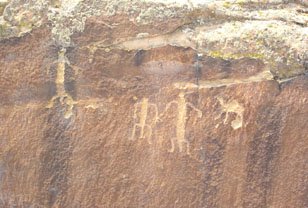 Native Americans carved these stone figures approximately 800 years ago, now to be seen in Petroglyph Canyon on the Montana-Wyoming border.
Native Americans carved these stone figures approximately 800 years ago, now to be seen in Petroglyph Canyon on the Montana-Wyoming border.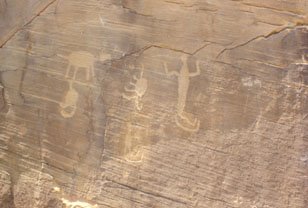 A variety of animal figures perhaps provided hopes for a bountiful hunt.
A variety of animal figures perhaps provided hopes for a bountiful hunt.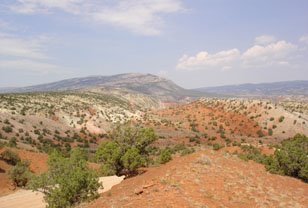 Spectacularly colorful Paleozoic and Mesozoic sedimentary rocks are exposed in the dissected Crooked Creek Anticline at the southwestern end of the Pryor Mountains.
Spectacularly colorful Paleozoic and Mesozoic sedimentary rocks are exposed in the dissected Crooked Creek Anticline at the southwestern end of the Pryor Mountains. Pigs jump from the starting gate as Montana’s favorite races get underway at the Bearcreek Saloon and bring our first week of digging to a close.
Pigs jump from the starting gate as Montana’s favorite races get underway at the Bearcreek Saloon and bring our first week of digging to a close. Another batch of photos ...
 Four articulated dorsal vertebral centra are exposed along the
Four articulated dorsal vertebral centra are exposed along thebottom edge of the main block of our “Dodson Diplodocus” at Rattlesnake Ridge. Another ten vertebrae in the series are covered with a preliminary plaster field jacket.
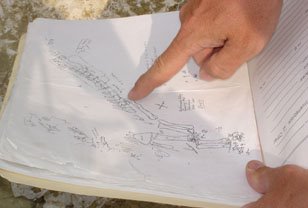 Glenn points out the mapped positions of “Dodson Diplodocus” skeletal elements as originally discovered.
Glenn points out the mapped positions of “Dodson Diplodocus” skeletal elements as originally discovered.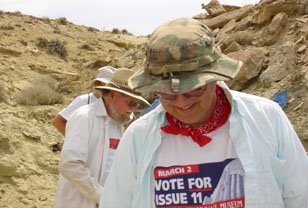 Glenn is a walking billboard for Cincinnati Museum Center while in the field!
Glenn is a walking billboard for Cincinnati Museum Center while in the field! One of the early homesteader cabins in the region remind us that those who tamed the western country lived not so may generations ago.
One of the early homesteader cabins in the region remind us that those who tamed the western country lived not so may generations ago.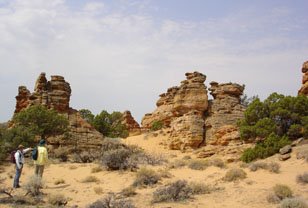 Glenn discusses ancient river channel cross-bedded sandstones with Museum Center board member Buck Niehoff.
Glenn discusses ancient river channel cross-bedded sandstones with Museum Center board member Buck Niehoff. Tuesday, August 01, 2006
August 1, 2006
Success! As you can see, I’ve gotten some pictures up at last. I hope you find them as interesting and inspiring as the crew and our field school participants do the real sights. I’ll be able to file some more shots as the weeks go on.
Aside from my computer issues, success came with an adventure of its own. My off day (from the field, not from work) between participant groups left me with a chance to catch up on paperwork and this blog. My latest idea was to go into town (Red Lodge) and find a high-speed connection. The first problem was that the library was closed on this day, Monday, but I’d been told that the coffee shop has a connection. The second problem was that in exchanging groups, while still getting digging done at both Mother’s Day and “Dodson,” I had been left without a vehicle. Red Lodge is several miles and 2,000 feet of elevation away (I may take up jogging when I get back, but not just yet, thanks) so walking did not seem like a good idea.
I was offered one of the YBRA geology vans (minus students on their field course) if I dropped it in town for new tires. Fine. I’d catch up on a few things and then drive on in. When I turned around, the van was gone (off to the airport, I learned – only to have a flat along the way!). OK. Last resort – the old camp truck. Earlier on this blog I was boasting of the Museum’s new Toyota Tundra. Now, I find myself in a 1970 (or thereabouts) Ford 150 Custom. Try that on the camp road for a bone rattling experience. It’s 3 on the floor with overdrive and a new clutch if you can reach it! I only remembered that it has a tendency to shake itself out of gear while fish-tailing on the way up the long, steep, very rough, dirt road hill, after I nearly rolled back down it. Nevermind. The pictures are up and nothing succeeds like success.
What else?…. Oh, yes, the fire. No sign of it now thankfully. I think it’s still a problem for Livingstone but is unlikely to jump to our area just now. And the weather has broken! Just 60 to 70 degrees today – what a relief (although the new winds bring the dust everywhere and threaten to blow down Mason’s less than quality tent)!
Bob, Brian, Mark and Lily, our new field schoolers, are enthusiastic dinosaur diggers and we got right to work today after the requisite geology tour. Brian has said repeatedly that he feels like it’s Christmas – the excitement of unearthing something not seen for 140 million years makes us all feel like kids. A variety of new bones are evident and we will soon get to removing them. I’ll try to tell you how that’s done soon.
Cheers for now!
Aside from my computer issues, success came with an adventure of its own. My off day (from the field, not from work) between participant groups left me with a chance to catch up on paperwork and this blog. My latest idea was to go into town (Red Lodge) and find a high-speed connection. The first problem was that the library was closed on this day, Monday, but I’d been told that the coffee shop has a connection. The second problem was that in exchanging groups, while still getting digging done at both Mother’s Day and “Dodson,” I had been left without a vehicle. Red Lodge is several miles and 2,000 feet of elevation away (I may take up jogging when I get back, but not just yet, thanks) so walking did not seem like a good idea.
I was offered one of the YBRA geology vans (minus students on their field course) if I dropped it in town for new tires. Fine. I’d catch up on a few things and then drive on in. When I turned around, the van was gone (off to the airport, I learned – only to have a flat along the way!). OK. Last resort – the old camp truck. Earlier on this blog I was boasting of the Museum’s new Toyota Tundra. Now, I find myself in a 1970 (or thereabouts) Ford 150 Custom. Try that on the camp road for a bone rattling experience. It’s 3 on the floor with overdrive and a new clutch if you can reach it! I only remembered that it has a tendency to shake itself out of gear while fish-tailing on the way up the long, steep, very rough, dirt road hill, after I nearly rolled back down it. Nevermind. The pictures are up and nothing succeeds like success.
What else?…. Oh, yes, the fire. No sign of it now thankfully. I think it’s still a problem for Livingstone but is unlikely to jump to our area just now. And the weather has broken! Just 60 to 70 degrees today – what a relief (although the new winds bring the dust everywhere and threaten to blow down Mason’s less than quality tent)!
Bob, Brian, Mark and Lily, our new field schoolers, are enthusiastic dinosaur diggers and we got right to work today after the requisite geology tour. Brian has said repeatedly that he feels like it’s Christmas – the excitement of unearthing something not seen for 140 million years makes us all feel like kids. A variety of new bones are evident and we will soon get to removing them. I’ll try to tell you how that’s done soon.
Cheers for now!
Photos of dinosaur finds!
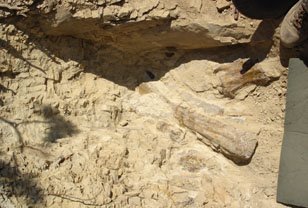 Work during the first week of Cincinnati Museum Center’s Dinosaur Field School has exposed a caudal (tail) vertebra and a lower limb bone (epipodial).
Work during the first week of Cincinnati Museum Center’s Dinosaur Field School has exposed a caudal (tail) vertebra and a lower limb bone (epipodial).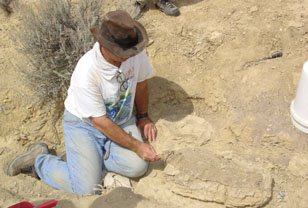 Dinosaur Field School participant Joe Gray uncovers a series of four articulated caudal (tail) vertebrae.
Dinosaur Field School participant Joe Gray uncovers a series of four articulated caudal (tail) vertebrae.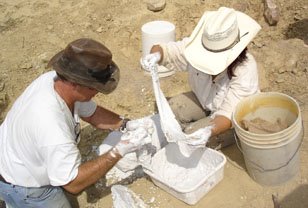 Mason and Joe apply plaster soaked burlaps strips to the block of caudal vertebrae. Note Joe’s wristwatch about to become a fossil!
Mason and Joe apply plaster soaked burlaps strips to the block of caudal vertebrae. Note Joe’s wristwatch about to become a fossil!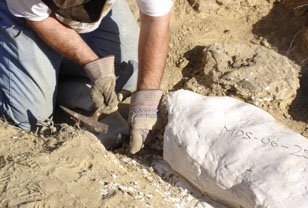 Joe begins to loosen the capped block from it’s home of 140 million years.
Joe begins to loosen the capped block from it’s home of 140 million years. Hands gather around, preparing to turn the block over in one quick motion.
Hands gather around, preparing to turn the block over in one quick motion.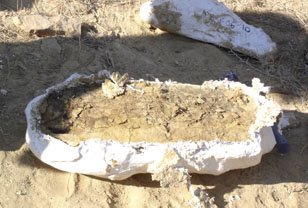 The underside of the block shows no exposed bones – a perfect flip!
The underside of the block shows no exposed bones – a perfect flip! The block containing the fossil vertebrae is ready to go!
The block containing the fossil vertebrae is ready to go!
Subscribe to:
Posts (Atom)